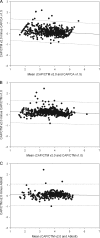Performance evaluation of the new Roche Cobas AmpliPrep/Cobas TaqMan HIV-1 test version 2.0 for quantification of human immunodeficiency virus type 1 RNA
- PMID: 20164281
- PMCID: PMC2849552
- DOI: 10.1128/JCM.01832-09
Performance evaluation of the new Roche Cobas AmpliPrep/Cobas TaqMan HIV-1 test version 2.0 for quantification of human immunodeficiency virus type 1 RNA
Abstract
Despite FDA approval and CE marking of commercial tests, manufacturer-independent testing of the technical aspects of newly developed tests is important. To evaluate the analytical performance and explore the clinical applicability of the new Roche COBAS AmpliPrep COBAS TaqMan HIV-1 test, version 2.0 (CAP/CTM v2.0), platform comparison was performed with the Roche CAP/CTM test, version 2.0, the COBAS Amplicor HIV-1 Monitor Test, version 1.5 (CAP/CA v1.5), the COBAS AmpliPrep COBAS TaqMan HIV-1 Test (CAP/CTM v1.0), and the Abbott m2000 RealTime HIV-1 assay on panels and diagnostic samples. Specificity was tested for HIV-2 samples. Furthermore, samples from HIV-1-seropositive individuals with CAP/CA v1.5-measured viral loads below 50 HIV-1 RNA copies per ml (cp/ml) and replicates of HIV-1-seronegative plasma were tested in a checkerboard analysis. CAP/CTM v2.0 is HIV-1 specific, with broad genotype inclusivity and no serious underquantification of viral load relative to the other assays used. Low viral loads below the threshold of quantification for CAP/CA v1.5 are observed with CAP/CTM v2.0. A CAP/CTM v2.0-measured viral load of >50 copies/ml in these samples correlated with therapy failure. In conclusion, CAP/CTM v2.0 is an accurate and reliable test for HIV-1 viral load measurement relative to the other assays used with respect to specificity, sensitivity, and genotype inclusivity.
Figures






Similar articles
-
Correction of underquantification of human immunodeficiency virus type 1 load with the second version of the Roche Cobas AmpliPrep/Cobas TaqMan assay.J Clin Microbiol. 2010 Apr;48(4):1337-42. doi: 10.1128/JCM.01226-09. Epub 2010 Feb 17. J Clin Microbiol. 2010. PMID: 20164284 Free PMC article.
-
Comparison between the automated Roche Cobas AmpliPrep/Cobas TaqMan HIV-1 test version 2.0 assay and its version 1 and Nuclisens HIV-1 EasyQ version 2.0 assays when measuring diverse HIV-1 genotypes in China.J Clin Virol. 2012 Jan;53(1):33-7. doi: 10.1016/j.jcv.2011.10.001. Epub 2011 Nov 2. J Clin Virol. 2012. PMID: 22051503
-
Comparison of the Roche COBAS AmpliPrep/COBAS TaqMan HIV-1 test v1.0 with v2.0 in HIV-1 viral load quantification.Kaohsiung J Med Sci. 2015 Apr;31(4):188-93. doi: 10.1016/j.kjms.2014.12.010. Epub 2015 Feb 3. Kaohsiung J Med Sci. 2015. PMID: 25835274 Free PMC article.
-
Evaluation of the NucliSens EasyQ v2.0 assay in comparison with the Roche Amplicor v1.5 and the Roche CAP/CTM HIV-1 Test v2.0 in quantification of C-clade HIV-1 in plasma.PLoS One. 2014 Aug 26;9(8):e103983. doi: 10.1371/journal.pone.0103983. eCollection 2014. PLoS One. 2014. PMID: 25157919 Free PMC article.
-
Translational HIV-1 research: from routine diagnostics to new virology insights in Amsterdam, the Netherlands during 1983-2013.Retrovirology. 2013 Aug 28;10:93. doi: 10.1186/1742-4690-10-93. Retrovirology. 2013. PMID: 23985078 Free PMC article. Review.
Cited by
-
Nucleic acid testing and molecular characterization of HIV infections.Eur J Clin Microbiol Infect Dis. 2019 May;38(5):829-842. doi: 10.1007/s10096-019-03515-0. Epub 2019 Feb 23. Eur J Clin Microbiol Infect Dis. 2019. PMID: 30798399 Review.
-
Detection and quantification of residual low-level HIV viremia in plasma based on extracellular particle co-isolation.Chin Med J (Engl). 2024 Dec 20;137(24):3136-3138. doi: 10.1097/CM9.0000000000003327. Epub 2024 Oct 25. Chin Med J (Engl). 2024. PMID: 39725638 Free PMC article. No abstract available.
-
Evaluation of quantification of HIV-1 RNA viral load in plasma and dried blood spots by use of the semiautomated Cobas Amplicor assay and the fully automated Cobas Ampliprep/TaqMan assay, version 2.0, in Kisumu, Kenya.J Clin Microbiol. 2013 Apr;51(4):1208-18. doi: 10.1128/JCM.03048-12. Epub 2013 Feb 6. J Clin Microbiol. 2013. PMID: 23390278 Free PMC article.
-
Increased risk of virologic rebound in patients on antiviral therapy with a detectable HIV load <48 copies/mL.PLoS One. 2012;7(11):e50065. doi: 10.1371/journal.pone.0050065. Epub 2012 Nov 15. PLoS One. 2012. PMID: 23166820 Free PMC article.
-
Point-of-Care HIV Viral Load Testing: an Essential Tool for a Sustainable Global HIV/AIDS Response.Clin Microbiol Rev. 2019 May 15;32(3):e00097-18. doi: 10.1128/CMR.00097-18. Print 2019 Jun 19. Clin Microbiol Rev. 2019. PMID: 31092508 Free PMC article. Review.
References
-
- Abbott, M. A., B. J. Poiesz, B. C. Byrne, S. Kwok, J. J. Sninsky, and G. D. Ehrlich. 1988. Enzymatic gene amplification: qualitative and quantitative methods for detecting proviral DNA amplified in vitro. J. Infect. Dis. 158:1158-1169. - PubMed
-
- Aberg, J. A., J. E. Kaplan, H. Libman, P. Emmanuel, J. R. Anderson, V. E. Stone, J. M. Oleske, J. S. Currier, and J. E. Gallant. 2009. Primary care guidelines for the management of persons infected with human immunodeficiency virus: 2009 update by the HIV Medicine Association of the Infectious Diseases Society of America. Clin. Infect. Dis. 49:651-681. - PubMed
-
- Compton, J. 1991. Nucleic acid sequence-based amplification. Nature 350:91-92. - PubMed
-
- de Baar, M. P., M. W. van Dooren, E. de Rooij, M. Bakker, B. van Gemen, J. Goudsmit, and A. de Ronde. 2001. Single rapid real-time monitored isothermal RNA amplification assay for quantification of human immunodeficiency virus type 1 isolates from groups M, N, and O. J. Clin. Microbiol. 39:1378-1384. - PMC - PubMed
-
- Dewar, R. L., H. C. Highbarger, M. D. Sarmiento, J. A. Todd, M. B. Vasudevachari, R. T. Davey, Jr., J. A. Kovacs, N. P. Salzman, H. C. Lane, and M. S. Urdea. 1994. Application of branched DNA signal amplification to monitor human immunodeficiency virus type 1 burden in human plasma. J. Infect. Dis. 170:1172-1179. - PubMed
Publication types
MeSH terms
Substances
LinkOut - more resources
Full Text Sources
Medical
Miscellaneous

